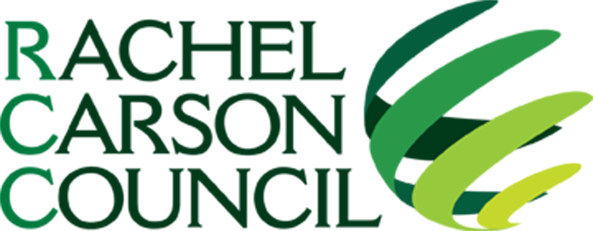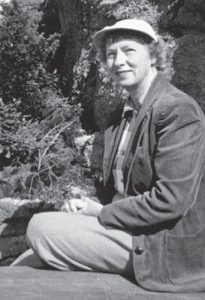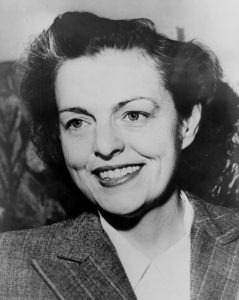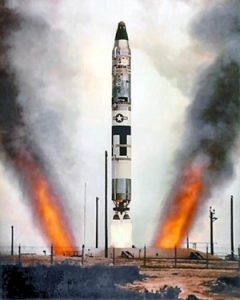Rachel Carson and Nuclear War
Taunts, threats, and belligerent policies have brought the U.S. to the precipice of nuclear war. Distressingly, U.S. war plans delegate the authority to use nuclear weapons to area military commanders, while the Trump Administration has proceeded to develop plans to increase the capacity of U.S. nuclear weapons. Musil reflects on how, despite the obvious threats to every form of life, environmental leaders and organizations have not applied the same effort to resisting nuclear dangers as they have to advocating for climate action. Highlighting Rachel Carson’s efforts and connections to the opposition of using nuclear weapons, Musil encourages environmental leaders to take action and speak out against nuclear threats.
 Rachel Carson, perhaps the greatest, and certainly the best known, environmentalist of the twentieth century, was deeply opposed to nuclear testing and nuclear war from at least 1946. There can be little doubt that she would be speaking out now, along with Pope Francis, against our return to the precipice of nuclear war brought on by the taunts, the threats, and the policies and plans of President Donald Trump and his allies in the Republican-controlled U.S. Congress.
Rachel Carson, perhaps the greatest, and certainly the best known, environmentalist of the twentieth century, was deeply opposed to nuclear testing and nuclear war from at least 1946. There can be little doubt that she would be speaking out now, along with Pope Francis, against our return to the precipice of nuclear war brought on by the taunts, the threats, and the policies and plans of President Donald Trump and his allies in the Republican-controlled U.S. Congress.
 Nevertheless, with a few exceptions like Greenpeace which was founded in 1971 to oppose nuclear testing, few contemporary environmental leaders, organizations, or writers have joined, in any meaningful way, the renewed and growing opposition to the current nuclear brinkmanship and war planning. As I wrote when Donald Trump first threatened nuclear war, it was not always this way. Today’s environmentalists can learn much from Rachel Carson and her contemporaries who saw nuclear war, pollution, and even poverty and war itself, as part of an entire ethos based on greed, domination, and a reckless faith in science unconstrained by moral principle.
Nevertheless, with a few exceptions like Greenpeace which was founded in 1971 to oppose nuclear testing, few contemporary environmental leaders, organizations, or writers have joined, in any meaningful way, the renewed and growing opposition to the current nuclear brinkmanship and war planning. As I wrote when Donald Trump first threatened nuclear war, it was not always this way. Today’s environmentalists can learn much from Rachel Carson and her contemporaries who saw nuclear war, pollution, and even poverty and war itself, as part of an entire ethos based on greed, domination, and a reckless faith in science unconstrained by moral principle.
Rachel Carson’s Silent Spring begins with an epigraph from Dr. Albert Schweitzer, the 1952 winner of the Nobel Prize for Peace, who used his Nobel address to oppose nuclear testing. “Man has lost the capacity to foresee and forestall. He will end by destroying the earth.” Carson corresponded with Schweitzer and shared his “reverence for life” in which all creatures were worthy of respect and protection. And, she repeatedly linked the twin evils of nuclear weapons and widespread chemical contamination.
Rachel Carson’s views on nuclear weapons and testing were directly shaped as early as the first two atomic bomb tests conducted by the United States after the destruction of Hiroshima and Nagasaki. In 1946, the U.S. carried out Operation Crossroads at Bikini Atoll in the South Pacific. In an exercise utilizing surplus navy vessels, two atomic bombs similar to those that destroyed the city of Nagasaki were detonated – one from beneath the ships, the other dropped from a B-29 bomber. American scientists were charged with studying the biological effects of radiation on various flora and fauna surrounding the ships. The research was headed by Roger Revelle, a leading World War II oceanographer, whom Carson had met during the war. She edited the US Fish and Wildlife Service biological survey of the islands before the tests and read Revelle’s reports about effects after the two blasts. Carson, who had opposed the tests in the first place, now had her anti-nuclear stance firmly supported by direct scientific evidence.
Rachel Carson must also have been influenced by Norman Cousins, editor of the influential weekly magazine, The Saturday Review. Cousins was the first American journalist to denounce the bombing of Hiroshima in an editorial shortly afterward, headed a project to give medical assistance to Japanese women horribly scarred by the Bomb, and became the Chairman of the Board of the Committee for a Sane Nuclear Policy, the largest nuclear disarmament group of the time. The Saturday Review favorably reviewed Carson’s first 1941 book, Under the Sea-Wind, and Norman Cousins selected Carson for the Westinghouse Science Writing Award in 1950. When The Sea Around Us was published in 1951, Cousins adorned the July 7 Saturday Review cover with Carson’s picture.
Rachel Carson also corresponded with and got scientific information on nuclear testing and radiation from the biologist, Dr. Barry Commoner, then with the St. Louis-based Committee for Nuclear Information. It collected baby’s teeth nationwide, revealing the widespread dispersion of Strontium-90, a radioactive by-product of nuclear tests that entered humans through milk consumption.
Perhaps the most surprising connection of Rachel Carson with opposition to nuclear war is through her close relationship with her literary agent, Marie Rodell. Rodell, an outspoken and progressive former mystery writer, had represented Helen Gahagan Douglas, the former movie star and liberal congresswoman who ran against Richard Nixon in the 1948 US Senate race in California. Nixon succeeded with a vicious red-baiting campaign, characterizing Douglas as the “the pink lady.” By 1957, just before Carson and Rodell were to begin work on Silent Spring, Rodell also helped publish Stride Toward Freedom, the first book by a young, rising civil rights leader, Dr. Martin Luther King, Jr.
 Rachel Carson would have been more aware than others at the time of King’s views on civil rights and on nuclear war. When asked as early as December, 1957 for his views about nuclear weapons, Dr. King replied,
Rachel Carson would have been more aware than others at the time of King’s views on civil rights and on nuclear war. When asked as early as December, 1957 for his views about nuclear weapons, Dr. King replied,
I definitely feel that the development and use of nuclear weapons should be banned. It cannot be disputed that a full-scale nuclear war would be utterly catastrophic. Hundreds and millions of people would be killed outright by the blast and heat, and by the ionizing radiation produced at the instant of the explosion . . . Even countries not directly hit by bombs would suffer through global fall-outs. All of this leads me to say that the principal objective of all nations must be the total abolition of war.”
King went on to sign an ad in 1958 sponsored by SANE, the leading disarmament group, and remained publically connected to the organization.
As nuclear testing continued and Cold War tensions rose, Rachel Carson chose to expose the dangers of dumping nuclear wastes into the ocean in her revised 1961 edition of her best-seller, The Sea Around Us. By 1963, in the final year of her life, she detailed in a speech to some 1500 physicians in California exactly how radionuclides, whether from nuclear wastes or nuclear bomb tests, move through the food chain and are dispersed to seeming remote places like the Arctic where they harm the breast-fed children of Eskimo mothers. Here Carson first identified herself as an ecologist who argued that it is critical to connect biological effects across ecosystems and species (including distant humans) and to link and understand seemingly separate issues like pollution, nuclear contamination, and human health.
Only after Carson’s death did a team of scientists led by Richard Turco estimate that even the use of a relatively small number of nuclear weapons (100) in war could create not only blast and radioactive fallout, but also clouds of sooty, toxic materials from destroyed cities and targets that could block the sun’s warming rays reaching earth. The effect, named by Turco, and first made widely known by the popular physicist Carl Sagan is known as nuclear winter. The entire earth would cool and be unable to produce crops to sustain human life. The result would be not just the destruction of societies in the Northern Hemisphere like the United States, Soviet Union, and Europe, but a mass extinction.
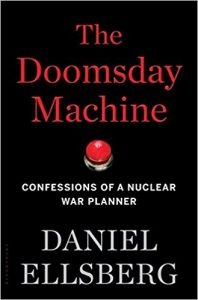 The research on nuclear winter has since been corroborated and improved through papers presented at the American Geophysical Union, and elsewhere. But, what is little understood, and emphasized in former nuclear war planner Daniel Ellsberg’s book, The Doomsday Machine, is that American nuclear war planning, through our long-secret Strategic Integrated Operating Plan or SIOP, assumes to this day that if the United States, or any of its allies, is ever attacked with any number of nuclear weapons, the response will be a full-scale total nuclear response using thousands of nuclear weapons from missiles, submarines, and bombers. Just as distressing is that US war plans delegate the authority to use nuclear weapon to area military commanders. A rogue officer or a false alarm could, indeed, set off nuclear war and nuclear winter.
The research on nuclear winter has since been corroborated and improved through papers presented at the American Geophysical Union, and elsewhere. But, what is little understood, and emphasized in former nuclear war planner Daniel Ellsberg’s book, The Doomsday Machine, is that American nuclear war planning, through our long-secret Strategic Integrated Operating Plan or SIOP, assumes to this day that if the United States, or any of its allies, is ever attacked with any number of nuclear weapons, the response will be a full-scale total nuclear response using thousands of nuclear weapons from missiles, submarines, and bombers. Just as distressing is that US war plans delegate the authority to use nuclear weapon to area military commanders. A rogue officer or a false alarm could, indeed, set off nuclear war and nuclear winter.
The recent 38-minute false nuclear alarm in Hawaii that told citizens — who then took shelter and cowered in fear — that a nuclear missile attack was underway has underscored the recklessness of President Trump’s nuclear war posturing and threats. They not only may provoke North Korea or other nuclear powers, they also create crisis-like, tense conditions where a US military commander is more likely to assume with any alert or warning that the US is indeed under nuclear attack and that a nuclear response is required.
Meanwhile, the Trump Administration has proceeded, with less notice, to develop plans and budgets to increase the number and kinds of US nuclear weapons and the vehicles to carry and launch them. And, finally, on January 12, 2018, a draft of the Pentagon’s new Nuclear Posture Review (NPR), to be released in February, was obtained by the Huffington Post. The new NPR lays out US nuclear war fighting policy. In sum, it calls for an increase in “smaller” US nuclear weapons, a move that undercuts and signals a potential end to relying on US nuclear weapons to deter an attack. Instead, it seems to say the US must be ready to use nuclear weapons in a variety of circumstances.
High-level officials like former Secretary of Defense William Perry and numerous arms control organizations have been quick to alert the public to the dangers of inadvertent nuclear war and to offer policy steps to reduce the risk of launching one. But in the face of real and rising dangers of a nuclear war that could destroy many forms of life on earth, not just human civilization, environmental leaders have been silent. They have not offered the kind of stern warnings, science-based analysis, and policy solutions that they have for global climate change.
Given the huge resources and millions of members committed to environmental organizations, their inclusion of nuclear weapons and war as threats to the global environment would have a major impact. Following President’s nuclear threats, the false warning that Hawaii was under nuclear attack, and the release of the Trump Administration’s Nuclear Posture Review that calls for more and more “usable” nuclear weapons, the time for environmental groups and leaders to speak out and join with peace and arms control organizations is now here.
